Multi-Level Gray Evaluation Method for Assessing Health Risks in Indoor Environments
Abstract
1. Introduction
1.1. Background
1.2. Literature Review
1.2.1. Thermal Responses
1.2.2. Evaluation Methods
1.2.3. Early Warning System
1.3. Research Gaps
- (1)
- Most evaluation methods rely on the AHP and the fuzzy comprehensive evaluation method. In the AHP method, due to subjectivity and a complex scale system, the results are not accurate enough and repeated calculations are required when the results do not meet the requirements of the consistency test. For the fuzzy comprehensive evaluation method, the use of an inappropriate membership function may lead to large deviations in the evaluation results.
- (2)
- The current high-temperature warning system primarily focuses on temperature alone, which fails to accurately reflect the actual heat exposure levels and associated health risks.
1.4. Research Contributions
- (1)
- Improves the traditional AHP method by simplifying the scale system. The improved AHP only considers a three item scale instead of the original nine item scale. This method decreases the impact of subjectivity and constantly meets the consistency requirements. In addition, a multi-level gray evaluation method is adopted to address disparities and uncertainties in the evaluation process, integrating both quantitative and qualitative indicators into the comprehensive gray evaluation framework.
- (2)
- An indoor human health risk early warning system for high-temperature weather has been developed, incorporating various indicators, including human status, building conditions, and weather forecasts. Unlike existing early warning systems, the proposed system specifically focuses on indoor human health, allowing individuals to accurately assess their health risk levels and take preventive measures against heatstroke in high-temperature conditions.
2. Methodology
2.1. Improved AHP
- (1)
- Instead of the previous nine item scale, a three item scale is used to determine the importance of two indicators, which simplifies the process of constructing the matrix.
- (2)
- It is unnecessary to check the consistency of the matrix, avoiding complicated calculation.
- (1)
- Construct a comparison matrix:
- (2)
- Determine the optimal transfer matrix: B = (bij)n×n
- (3)
- Determine the optimal quasi-optimal uniform matrix: A* = (aij*)n×n
- (4)
- Calculate the weight:
- (5)
- After normalization, W can be obtained as W = (W1, W2, …, Wn), and
2.2. Multi-Level Gray Evaluation Method
- (1)
- Develop a rating scale for the evaluation indicators to evaluate the qualitative indicators.
- (2)
- Calculate the weight of each indicator.
- (3)
- Organize a group of experts to score and establish a sample evaluation matrix. Assume the kth expert’s score is dijk, then the matrix can be obtained as D.
- (4)
- Determine the evaluation of the gray class and gray evaluation coefficients. Determining the evaluation of the gray class is to determine the grade of the gray class, the gray number of the gray class, and the whitening weight function. Assuming that the evaluation of gray class number is e (e = 1, 2, …, g), a certain whitening weight function to describe the gray class can be selected. For uij, its gray evaluation coefficient belonging to eth class is as follows:
- (5)
- Calculate the gray evaluation weight vector and weight matrix. The weight vector for the belonging to the eth gray class is as follows:
- (6)
- Evaluate ui and U. The comprehensive evaluation ui is as follows:
2.3. Flow Chart of Methods
- (1)
- Step 1: establish an evaluation index system and divide the indicators into qualitative and quantitative indicators.
- (2)
- Step 2: use the AHP method to calculate the weight of all indicators.
- (3)
- Step 3: develop a rating scale for qualitative indicators and invite experts to give a corresponding score.
- (4)
- Step 4: establish functions between scores and quantitative indicators, then calculate the score according to specific values of the quantitative indicators and established equations.
- (5)
- Step 5: combine the weights calculated by the improved AHP with the multi-level gray evaluation method to receive the comprehensive evaluation results.
3. Establishment of the Health Risk Evaluation and Early Warning System
3.1. Establishment of Indicator System
3.2. Determination of Indicator Weight
3.3. Comprehensive Evaluation of Indoor Human Health Risk
- (1)
- Qualitative indicators
- (2)
- Quantitative indicators
- (3)
- Evaluation Process
3.4. Early Warning System
4. Case Study
4.1. Subjects
- (1)
- Four males and four females were selected;
- (2)
- Two youth individuals, two elderly individuals, and four middle-aged individuals were selected.
4.2. Evaluation for Qualitative Indicators
4.3. Evaluation for Quantitative Indicators
5. Results and Discussion
5.1. Evaluation Results
- (1)
- The scores of the subjects will decrease as the outdoor environment deteriorates. Consequently, all subjects receive their highest scores on 22 July.
- (2)
- Among all subjects, the evaluation scores for young individuals are the highest, followed by middle-aged individuals, while elderly individuals receive the lowest. The maximum score for young individuals is 3.41, whereas the highest score for middle-aged individuals is 2.93. For elderly individuals, only 2.5 points are scored. It confirms that the elderly individuals are more susceptible to high temperatures.
- (3)
- The scores of males are commonly higher than those of females. The highest evaluation score for males is 3.41, while for females the highest score is 3.1, proving that females are more susceptible to high temperatures.
5.2. Early Warning Results
6. Conclusions
- (1)
- This system considers three first level indicators. Among them, the weight of the human is 0.79 and the weight of the weather and building are 0.17, 0.04, respectively. Moreover, fifteen second level indicators are considered, and the weights of health status, temperature and manual adjustment are larger than other indicators.
- (2)
- The results of the health risk evaluation shows that the highest evaluation score for young individuals is 3.41, while elderly males receive the highest score of 2.5. Furthermore, the highest evaluation score for males is 3.41, while for females the highest score is 3.1.
- (3)
- Compared with the traditional temperature-based warning system, the comprehensive early warning system presents more accurate results. Even under identical weather conditions, individuals from different age groups receive varying outcomes. Due to their weak physique, elderly individuals triggered red alerts at 33 °C. However, even under 38 °C conditions, no alert is issued for young individuals.
Author Contributions
Funding
Institutional Review Board Statement
Informed Consent Statement
Data Availability Statement
Acknowledgments
Conflicts of Interest
Appendix A
| Indicator | Sub—Factor | Score | Description | Sign | Indicator | Sub—Factor | Score | Description | Sign |
|---|---|---|---|---|---|---|---|---|---|
| Human () | Age () | 4 | 5 ≤ age < 18 | [ ] | Nutritional status () | 4 | excellent | [ ] | |
| 3 | 18 ≤ age < 44 | [ ] | 3 | good | [ ] | ||||
| 2 | 44 ≤ age < 59 | [ ] | 2 | medium | [ ] | ||||
| 1 | age ≥ 59 or age < 5 | [ ] | 1 | poor | [ ] | ||||
| Body figure () | 4 | moderate | [ ] | Sleep status () | 4 | excellent | [ ] | ||
| 3 | thin | [ ] | 3 | good | [ ] | ||||
| 2 | obese | [ ] | 2 | medium | [ ] | ||||
| 1 | fat | [ ] | 1 | poor | [ ] | ||||
| Personality characteristics () | 4 | choleric temperament | [ ] | Gender () | 3 | man | [ ] | ||
| 3 | mucous | [ ] | 2 | woman | [ ] | ||||
| 2 | depressive | [ ] | Weather () | Temperature () | / | / | / | ||
| 1 | multi-blood | [ ] | Humidity () | / | / | / | |||
| Health status () | 4 | excellent | [ ] | Wind scale () | / | / | / | ||
| 3 | good | [ ] | Building () | Thermal insulationperformance () | 4 | excellent | [ ] | ||
| 2 | medium | [ ] | 3 | good | [ ] | ||||
| 1 | poor | [ ] | 2 | medium | [ ] | ||||
| Labor intensity () | 4 | excellent | [ ] | 1 | poor | [ ] | |||
| 3 | good | [ ] | Air tightness () | 4 | excellent | [ ] | |||
| 2 | medium | [ ] | 3 | good | [ ] | ||||
| 1 | poor | [ ] | 2 | medium | [ ] | ||||
| Physique status () | 4 | excellent | [ ] | 1 | poor | [ ] | |||
| 3 | good | [ ] | Manual adjustment () | 4 | air conditioner | [ ] | |||
| 2 | medium | [ ] | 3 | fan | [ ] | ||||
| 1 | poor | [ ] | 2 | natural ventilation | [ ] | ||||
| 1 | nothing | [ ] |
References
- Zuo, J.; Palmer, S.; Bennetts, H.; Chileshe, N.; Ma, T. Impacts of heat waves and corresponding measures: A review. J. Clean. Prod. 2014, 92, 1–12. [Google Scholar] [CrossRef]
- Hua, X.; Zhang, C.; Ren, Y.; Shi, T.C. Spatiotemporal assessment of extreme heat risk for high-density cities: A case study of Hong Kong from 2006 to 2016. Sustain. Cities Soc. 2021, 64, 102507. [Google Scholar] [CrossRef]
- Zheng, G.Z.; Li, C.; Gao, Y.F. Determining the thresholds of environmental parameters for health protection of sanitation workers in summer based on mathematical programming. Build. Environ. 2021, 188, 107442. [Google Scholar] [CrossRef]
- Zheng, G.Z.; Fan, Z.Z.; Ge, M.; Li, C. Establishing a warning index for evaluating the physiological stress of sanitation workers in high temperature weather. Build. Environ. 2021, 100, 103074. [Google Scholar] [CrossRef]
- Tang, Y.M. Relationships between micronutrient losses in sweat and blood pressure among heat exposed steelworkers. Ind. Health 2016, 54, 215–223. [Google Scholar] [CrossRef] [PubMed]
- Garcia, G.M.; De, C.B. Working conditions, occupational injuries, and health among Filipino fish processing workers in Dutch Harbor, Alaska. Workplace Health Saf. 2017, 65, 219–226. [Google Scholar] [CrossRef]
- Sugg, M.M.; Fuhrmann, C.M. Relationships between maximum temperature and heat-related illness across North Carolina, USA. Int. J. Biometeorol. 2016, 60, 663–675. [Google Scholar] [CrossRef] [PubMed]
- Kim, E.; Kim, H.; Kim, Y.C.; Lee, P.J. Association between extreme temperature and kidney disease in South Korea, 2003-2013: Stratified by sex and age groups. Sci. Total Environ. 2018, 642, 800–808. [Google Scholar] [CrossRef] [PubMed]
- Anderson, G.B.; Bell, M.L. Heat waves in the United States: Mortality risk during heat waves and effect modification by heatwave characteristics in 43 U. S. communities. Environ. Health Persp. 2011, 119, 210–218. [Google Scholar] [CrossRef]
- Carlson, L.A.; Ferguson, D.P.; Kenefick, R.W. Physiological strain of stock car drivers during competitive racing. J. Therm. Biol. 2014, 44, 20–26. [Google Scholar] [CrossRef] [PubMed]
- Jia, C.Y.; Li, Y.Y.; Gao, S.R.; Zhao, S.K.; Liu, S.C.; Zhang, H. Thermal responses under different exercise intensity and air temperature. Build. Environ. 2025, 271, 112591. [Google Scholar] [CrossRef]
- Wang, Z.; Ning, H.; Ji, Y. Human thermal physiological and psychological responses under different heating environments. J. Therm. Biol. 2015, 52, 177–186. [Google Scholar] [CrossRef]
- Zhao, P.; Zhu, N.; Chong, D.K.; Hou, Y.Z. Developing a new heat strain evaluation index to classify and predict human thermal risk in hot and humid environments. Sustain. Cities Soc. 2022, 76, 103440. [Google Scholar] [CrossRef]
- Yang, B.; Yao, H.C.; Yang, P.F.; Guo, Y.Y. Effects of thermal and acoustic environments on workers’ psychological and physiological stress in deep underground spaces. Build. Environ. 2022, 212, 112591. [Google Scholar] [CrossRef]
- Wang, Y.J.; Wang, Y.T.; Wang, X.M.; Wang, C.X.; Li, G. Experimental investigation on physiological and perceptual thermal responses through simulated hot-humid deep mine conditions. Build. Environ. 2024, 255, 111435. [Google Scholar] [CrossRef]
- Wei, D.Y.; Du, C.F.; Lin, Y.F.; Chang, B.M.; Wang, Y. Thermal environment assessment of deep mine based on analytichierarchy process and fuzzy comprehensive evaluation. Case Stud. Therm. Eng. 2020, 19, 100618. [Google Scholar] [CrossRef]
- Zheng, G.Z.; Zhu, N.; Tian, Z.; Chen, Y.; Sun, B.H. Application of a trapezoidal fuzzy AHP method for work safety evaluation and early warning rating of hot and humid environments. Saf. Sci. 2012, 50, 228–239. [Google Scholar] [CrossRef]
- Ramavandi, B.; Darabi, A.H.; Omidvar, M. Risk assessment of hot and humid environments through an integrated fuzzy AHP-VIKOR method. Stoch. Environ. Res. Risk Assess. 2021, 35, 2425–2438. [Google Scholar] [CrossRef]
- Yazdanirad, S.; Golbabaei, F.; Monazzam, M.; Dehghan, H.; Foroushani, A.R. Identification, classification, and prioritization of effective factors in producing thermal strain in men at workplaces using fuzzy AHP technique. Indian J. Occup. Environ. 2020, 24, 106–113. [Google Scholar]
- Zheng, G.Z.; Li, K.; Bu, W.T.; Wang, Y.J. Fuzzy comprehensive evaluation of human physiological state in indoor high temperature environments. Build. Environ. 2019, 150, 108–118. [Google Scholar] [CrossRef]
- Zhai, Y.; Wang, X.; Niu, H.; Wang, X.; Nie, Y.; Huang, Y. Fuzzy Comprehensive Evaluation of Human Work Efficiency in a High-Temperature Thermal-Radiation Environment. Sustainability 2022, 14, 13959. [Google Scholar] [CrossRef]
- Ni, X.; Li, J.; Xu, J.Y.; Shen, Y.; Liu, X.G. Grey relation analysis and multiple criteria decision analysis method model for suitability evaluation of underground space development. Eng. Geol. 2024, 338, 107608. [Google Scholar] [CrossRef]
- Kan, Z.; Wei, Y.M.; Zhao, T.Y.; Cao, J.T. Risk evaluation of submarine pipelines in FMEA by combination of gray relation projection and VIKOR method. Ocean. Eng. 2024, 302, 117695. [Google Scholar] [CrossRef]
- Pinheiro, B.C.; SanťAna, P.H.M. AHP-based decision making to selecting energy-efficient air conditioning equipments in a commercial building. Energ. Build. 2025, 329, 115281. [Google Scholar] [CrossRef]
- Cyrine, B.; Rihab, R.; Abdelaziz, S.; Sinda, S.; Noamen, R. Advanced groundwater potential and contamination vulnerability assessment using integrated GIS-based AHP techniques: A case study from the Bizerte watershed, Tunisia. Environ. Sustain. Ind. 2025, 26, 100597. [Google Scholar]
- Zheng, X.Y.; Liu, Q.; Li, Y.F.; Wang, B.; Qin, W.T. Safety risk assessment for connected and automated vehicles: Integrating FTA and CM-improved AHP. Reliab. Eng. Syst. Safe 2025, 257, 110822. [Google Scholar] [CrossRef]
- Wang, Y.; Wei, H.W.; Wen, J.; He, J.Y.; Li, P.C. Assessing organizational vulnerability of nuclear power plants using AHP-fuzzy sets method. Ann. Nucl. Energy 2025, 211, 110896. [Google Scholar] [CrossRef]
- Gao, X.; Jia, C.G.; Luo, S.L.; Liu, H.Y. Meteorological conditions and countermeasures of high temperature heatstroke in Anyang. In Proceedings of the Twenty-Eighth Annual Meeting of China Meteorological Society in 2011, Xiamen, China, 1–3 November 2011. [Google Scholar]
- Gao, P. Effect of Individual Difference on Physiological Responses Under Hot and Humid Environment. Master’s Thesis, Tianjin University, Tianjin, China, 2012. [Google Scholar]
- Zhou, Y.Y.; Zhang, S.Y.; Liu, H.C.; Kuang, Z.Z.; Tian, Y. Analysis of the impact of high temperature heat waves on death in the elderly in Nanjing from 2005 to 2008. In Proceedings of the 31st Annual Meeting of China Meteorological Society, Beijing, China, 3–5 November 2014. [Google Scholar]
- Iñiguez, C.; Schifano, P.; Asta, F.; Michelozzi, P.; Vicedo-Cabrera, A.; Ballester, F. Temperature in summer and children’s hospitalizations in two Mediterranean cities. Environ. Res. 2016, 150, 236–244. [Google Scholar] [CrossRef] [PubMed]
- Gong, Z.Y. Indoor Thermal Environment Control Based on Thermal Sensation Prediction. Master’s Thesis, North China University of Technology, Beijing, China, 2018. [Google Scholar]
- Matsee, W.; Charoensakulchai, S.; Khatib, A.N. Heat-related illnesses are an increasing threat for travellers to hot climate destinations. J. Travel. Med. 2023, 30, taad072. [Google Scholar] [CrossRef] [PubMed]
- Rodrigues, L.; Tubelo, R.; Pasos, A.V.; Gonçalves, J.C.S.; Wood, C.; Gillott, M. Quantifying airtightness in Brazilian residential buildings with focus on its contribution to thermal comfort. Build. Res. Inf. 2021, 49, 639–660. [Google Scholar] [CrossRef]
- Ding, Y.; Han, S.X.; Tian, Z.; Yao, J.; Chen, W.Y.; Zhang, Q. Review on occupancy detection and prediction in building simulation. Build. Simul. 2022, 15, 333–356. [Google Scholar] [CrossRef]
- Kenney, W.L.; Havenith, G. Heat stress and age: Skin blood flow and body temperature. J. Therm. Biol. 1993, 18, 341–344. [Google Scholar] [CrossRef]
- Gu, S.; Huang, C.; Li, B.; Chu, C.; Liu, Q. Heat-related illness in China, summer of 2013. Int. J. Biometeorol. 2016, 60, 131. [Google Scholar] [CrossRef] [PubMed]
- Joshi, A.; Wang, F.M.; Kang, Z.X.; Yang, B.; Zhao, D.L. A three-dimensional thermoregulatory model for predicting human thermophysiological responses in various thermal environments. Build. Environ. 2022, 207, 108506. [Google Scholar] [CrossRef]
- Duan, G.N.; Song, C.; Liu, Y.F.; Wang, D.J.; Suolang, B.M. Study on the influence of hypobaric hypoxia on human thermal comfort under step change thermal environments. Energ. Build. 2023, 279, 112683. [Google Scholar] [CrossRef]
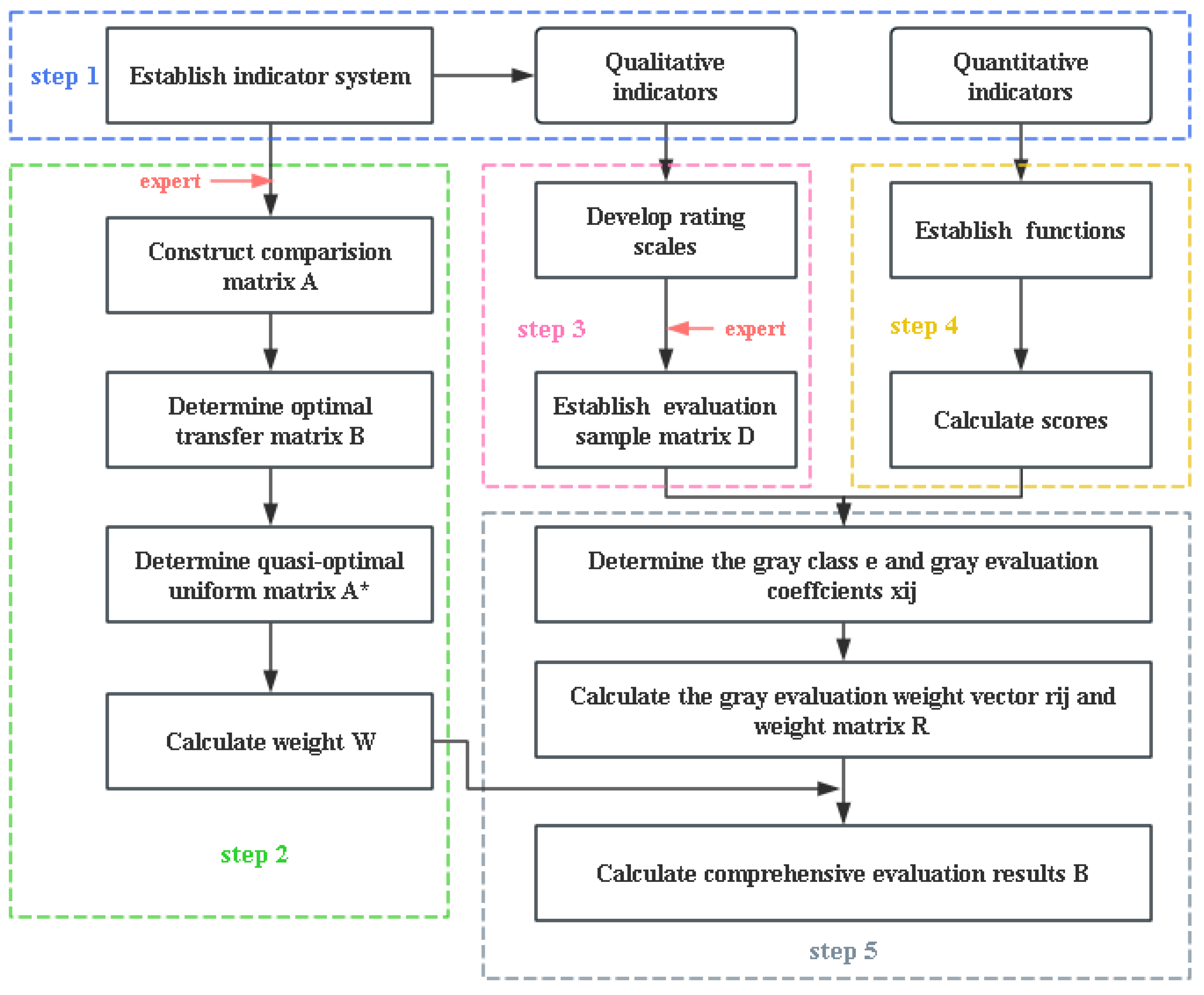
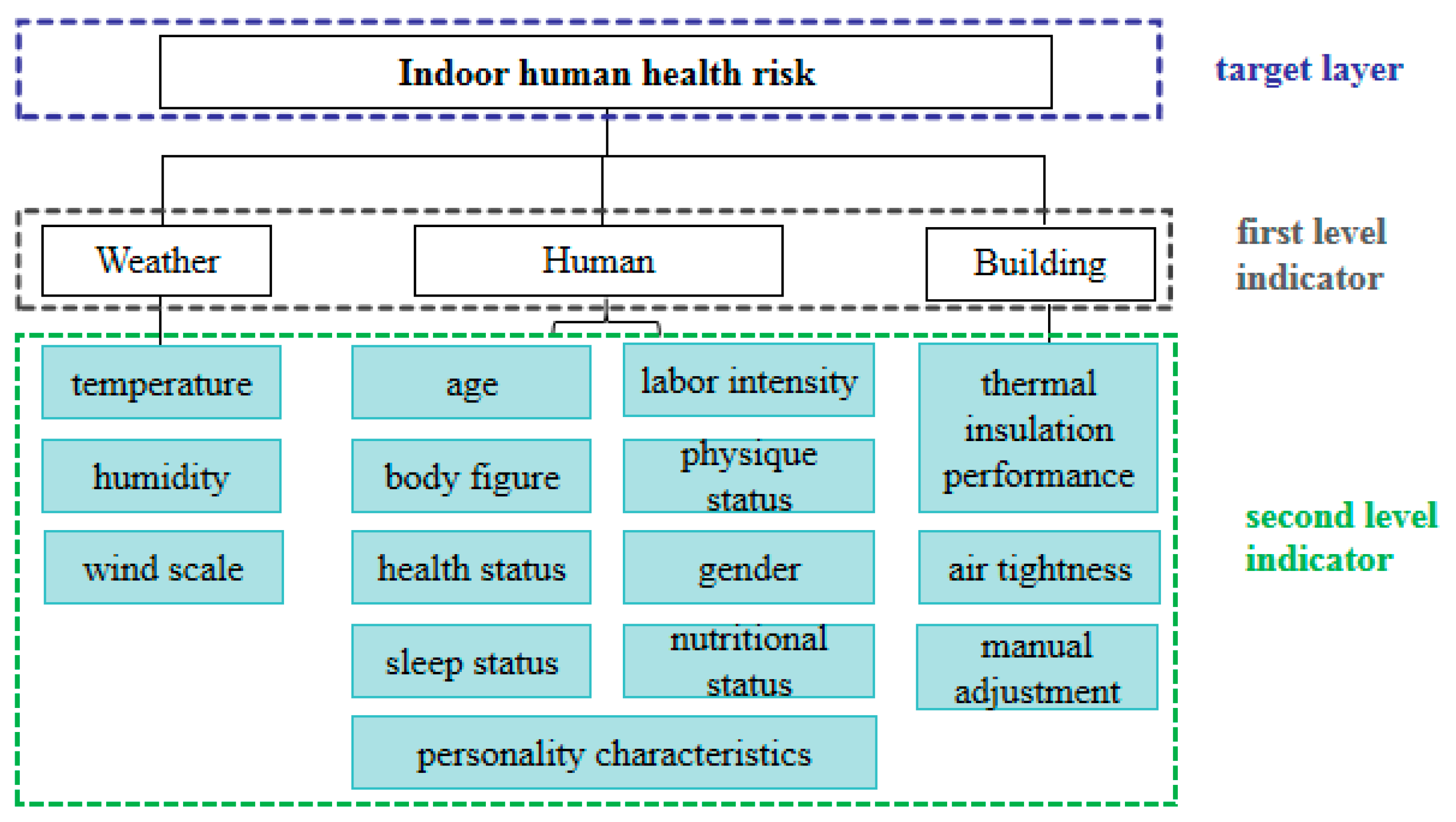
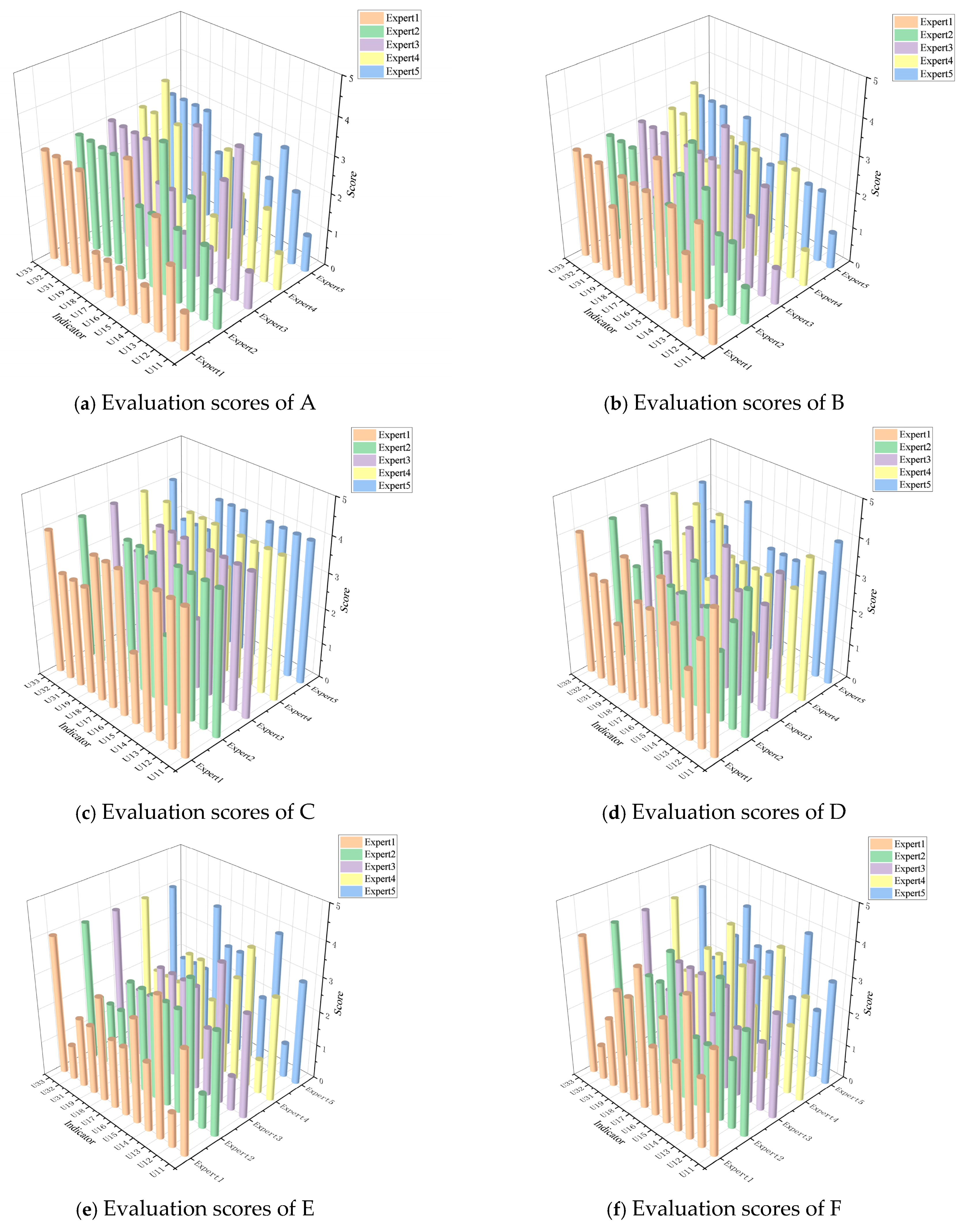

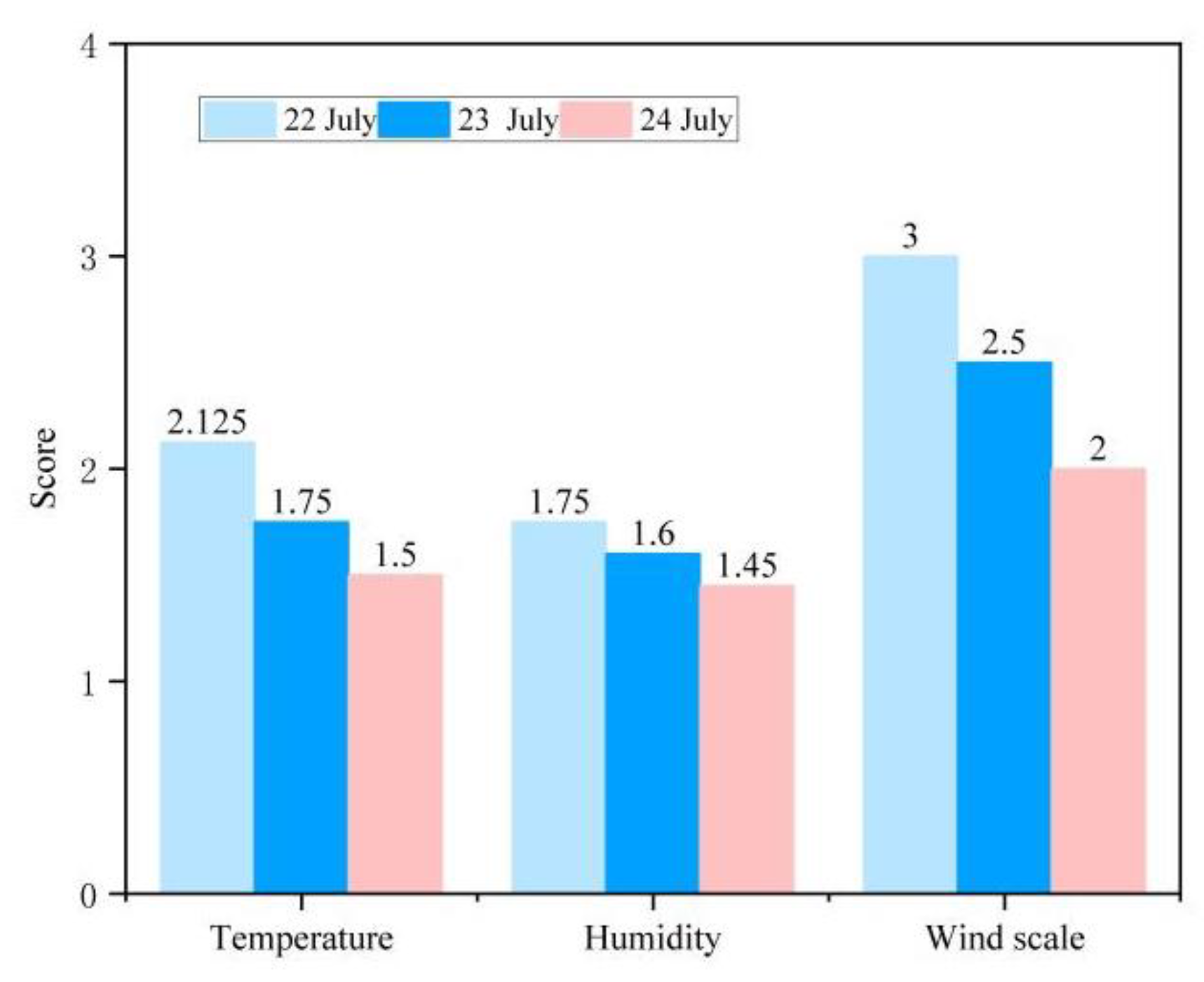
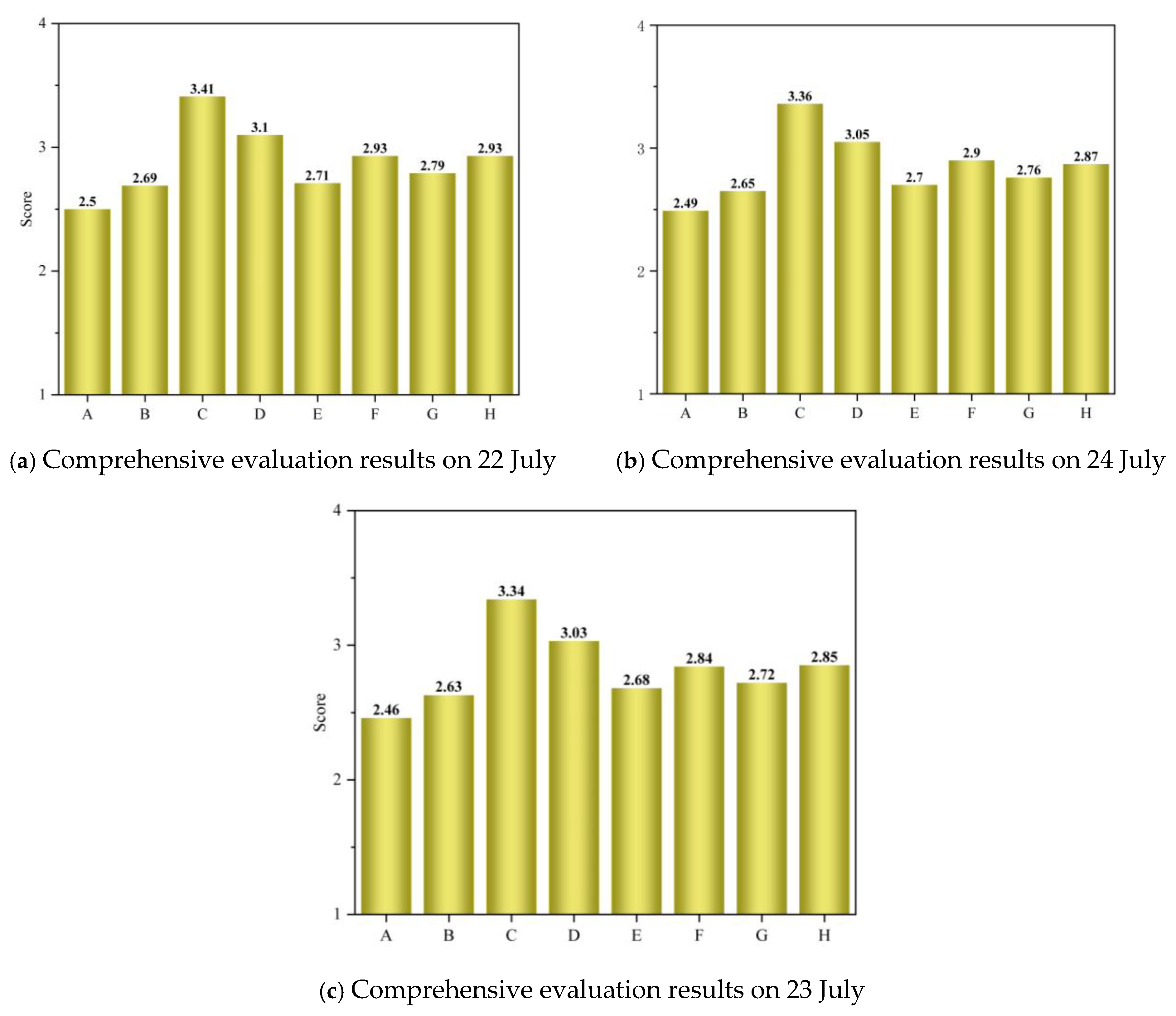
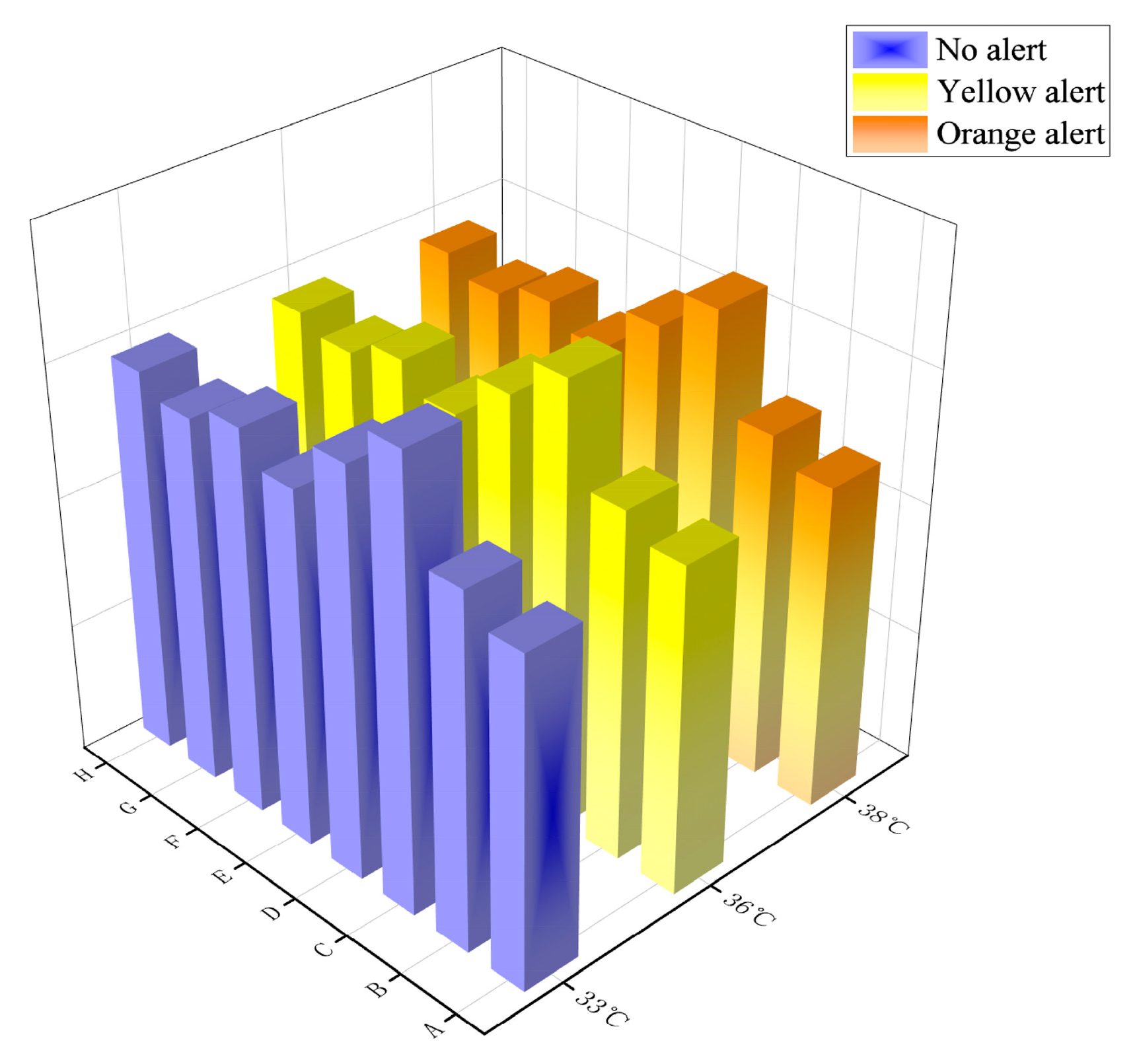
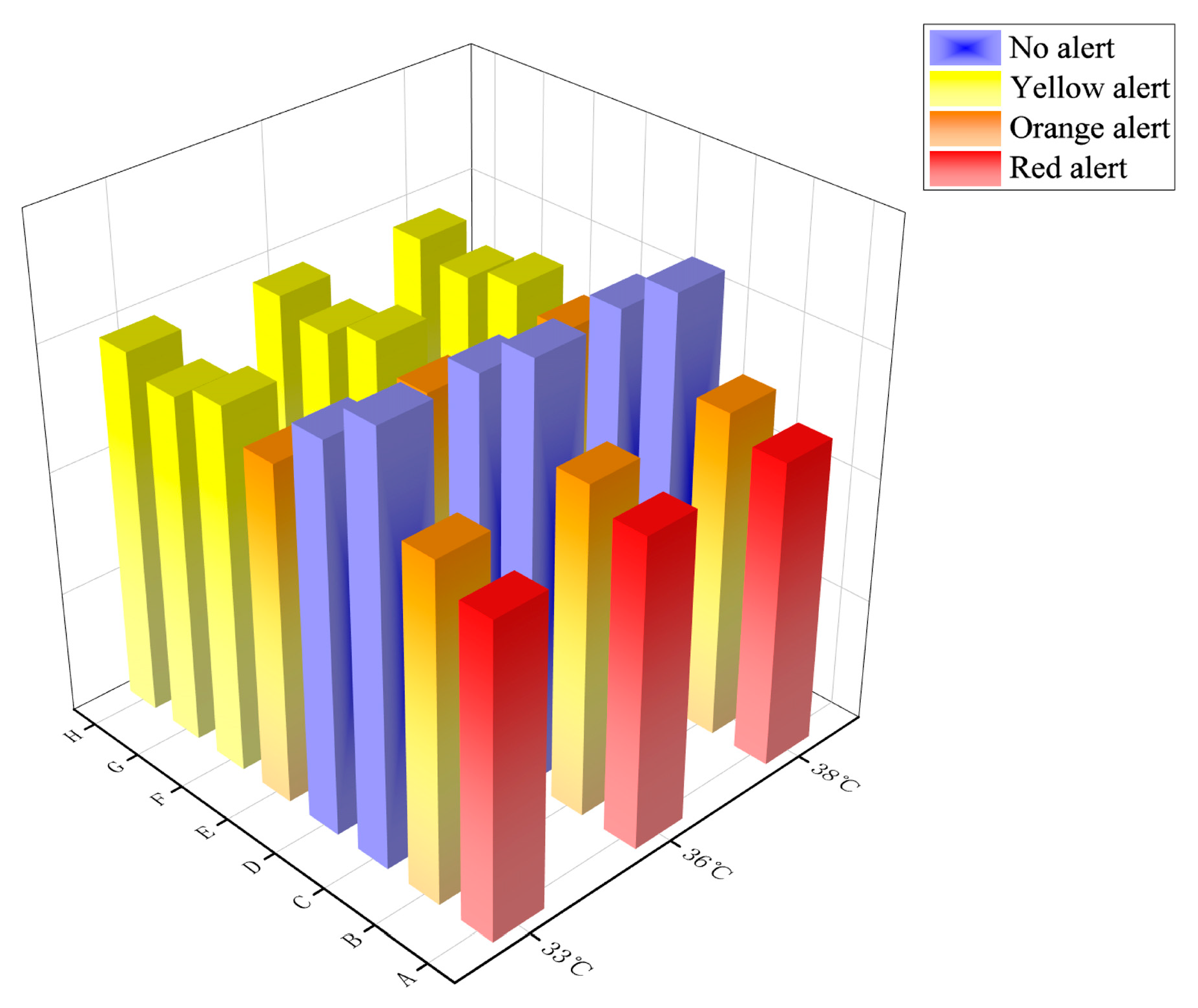
| Indicator | u1 | u2 | u3 | Weight |
|---|---|---|---|---|
| u1 | 0 | 1 | 1 | 0.79 |
| u1 | −1 | 0 | 1 | 0.17 |
| u3 | −1 | −1 | 0 | 0.04 |
| Indicator | u11 | u12 | u13 | u14 | u15 | u16 | u17 | u18 | u19 | Weight |
|---|---|---|---|---|---|---|---|---|---|---|
| u11 | 0 | 1 | 1 | 1 | 1 | 1 | 1 | 1 | 1 | 0.246 |
| u12 | −1 | 0 | 1 | 1 | 1 | 1 | 1 | 1 | 1 | 0.025 |
| u13 | −1 | −1 | 0 | 1 | 1 | 1 | 1 | 1 | 1 | 0.006 |
| u14 | −1 | −1 | −1 | 0 | 1 | 1 | 1 | 1 | 1 | 0.411 |
| u15 | −1 | −1 | −1 | −1 | 0 | 0 | 0 | 0 | 1 | 0.148 |
| u16 | −1 | −1 | −1 | −1 | 0 | 0 | 0 | 0 | 1 | 0.025 |
| u17 | −1 | −1 | −1 | −1 | 0 | 0 | 0 | 0 | 1 | 0.025 |
| u18 | −1 | −1 | −1 | −1 | 0 | 0 | 0 | 0 | 1 | 0.025 |
| u19 | −1 | −1 | −1 | −1 | −1 | −1 | −1 | −1 | 0 | 0.089 |
| Indicator | u21 | u22 | u23 | Weight |
|---|---|---|---|---|
| u21 | 0 | 1 | 1 | 0.79 |
| u22 | −1 | 0 | 1 | 0.17 |
| u23 | −1 | −1 | 0 | 0.04 |
| Indicator | u31 | u32 | u33 | Weight |
|---|---|---|---|---|
| u31 | 0 | 1 | 1 | 0.17 |
| u32 | −1 | 0 | 1 | 0.04 |
| u33 | −1 | −1 | 0 | 0.79 |
| Gray Class e | Health Risk Level | Expression | Whitening Weight Function | |
|---|---|---|---|---|
| First gray class | Excellent | 1 ∈ [4, ∞] | dijk/4 | dijk ∈ [0, 4] |
| 1 | dijk ∈ [4, ∞] | |||
| 0 | dijk ∉ [0, ∞] | |||
| Second gray class | Good | 2 ∈ [0, 3, 6] | dijk/3 | dijk ∈ [0, 3] |
| (6 − dijk)/3 | dijk ∈ [3, 6] | |||
| 0 | dijk ∉ [0, 6] | |||
| Third gray class | Medium | 3 ∈ [0, 2, 4] | dijk/2 | dijk ∈ [0, 2] |
| (4 − dijk)/2 | dijk ∈ [2, 4] | |||
| 0 | dijk ∉ [0, 4] | |||
| Fourth gray class | Poor | 4 ∈ [0, 1, 2] | 1 | dijk ∈ [0, 1] |
| 2 − dijk | dijk ∈ [1, 2] | |||
| 0 | dijk ∉ [0, 2] | |||
| Score | [1.93–2.5] | (2.5–2.71] | (2.71–3.03] | (3.03–3.56] |
|---|---|---|---|---|
| Early warning | Red alert | Orange alert | Yellow alert | No alert |
| A | B | C | D | E | F | G | H | |
|---|---|---|---|---|---|---|---|---|
| Age | 60 | 60 | 17 | 17 | 42 | 42 | 50 | 50 |
| Gender | male | female | male | female | female | male | female | male |
| Date | Temperature | Humidity | Wind Scale |
|---|---|---|---|
| 23 July | 36 °C | 80% | 3 |
| 24 July | 38 °C | 85% | 2 |
| 22 July | 33 °C | 75% | 4 |
Disclaimer/Publisher’s Note: The statements, opinions and data contained in all publications are solely those of the individual author(s) and contributor(s) and not of MDPI and/or the editor(s). MDPI and/or the editor(s) disclaim responsibility for any injury to people or property resulting from any ideas, methods, instructions or products referred to in the content. |
© 2025 by the authors. Licensee MDPI, Basel, Switzerland. This article is an open access article distributed under the terms and conditions of the Creative Commons Attribution (CC BY) license (https://creativecommons.org/licenses/by/4.0/).
Share and Cite
Wang, Y.; Ding, Y.; Liu, C.; Liu, K. Multi-Level Gray Evaluation Method for Assessing Health Risks in Indoor Environments. Buildings 2025, 15, 789. https://doi.org/10.3390/buildings15050789
Wang Y, Ding Y, Liu C, Liu K. Multi-Level Gray Evaluation Method for Assessing Health Risks in Indoor Environments. Buildings. 2025; 15(5):789. https://doi.org/10.3390/buildings15050789
Chicago/Turabian StyleWang, Yajing, Yan Ding, Chunhua Liu, and Kuixing Liu. 2025. "Multi-Level Gray Evaluation Method for Assessing Health Risks in Indoor Environments" Buildings 15, no. 5: 789. https://doi.org/10.3390/buildings15050789
APA StyleWang, Y., Ding, Y., Liu, C., & Liu, K. (2025). Multi-Level Gray Evaluation Method for Assessing Health Risks in Indoor Environments. Buildings, 15(5), 789. https://doi.org/10.3390/buildings15050789






